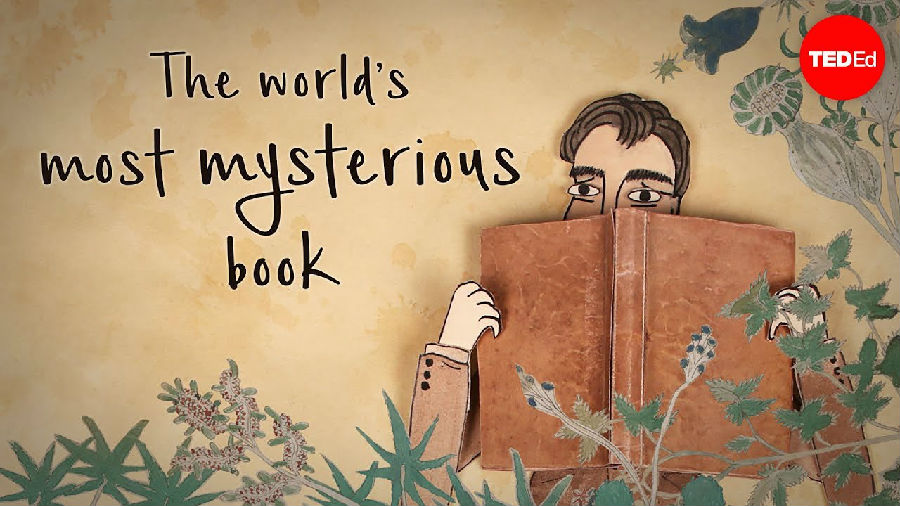(单词翻译:单击)
Deep inside Yale University's Beinecke Rare Book and Manuscript Library lies the only copy of a 240-page tome.
在耶鲁大学的拜内克古籍善本图书馆里,有一本240页古书的唯一复件。
Recently carbon dated to around 1420,
最近它被测得可以追溯至1420年左右,
its vellum pages features looping handwriting and hand-drawn images seemingly stolen from a dream.
它的牛皮封面上,不断循环的文字引人注目,手绘的图案仿佛是梦中所得。
Real and imaginary plants, floating castles, bathing women, astrology diagrams,
真假交错的植物,悬浮空中的城堡,正在洗浴的妇女,星象图,
zodiac rings, and suns and moons with faces accompany the text.
星座戒指,还有文字周围的脸谱化的日月。
This 24x16 centimeter book is called the Voynich manuscript, and its one of history's biggest unsolved mysteries.
这本24厘米长、16厘米宽的古书,被称作伏尼契手稿,它是历史上最大的未解之谜之一。
The reason why? No one can figure out what it says.
为什么呢?没人知道这本书在说什么。
The name comes from Wilfrid Voynich, a Polish bookseller who came across the document at a Jesuit college in Italy in 1912.
书的名字来源于威尔弗雷德·伏尼契,在1912年的意大利,一个碰巧在天主教书院看到这本书的波兰裔书商。
He was puzzled. Who wrote it? Where was it made?
他被难住了。谁写的这本书?在哪里写的?
What do these bizarre words and vibrant drawings represent? What secrets do its pages contain?
这些奇怪的文字和鲜艳的图画代表着什么?书里到底隐含着什么秘密?
He purchased the manuscript from the cash-strapped priest at the college,
他从书院拮据的牧师那儿买下了这份手稿,
and eventually brought it to the U.S., where experts have continued to puzzle over it for more than a century.
并最终带回了美国,在美国,专家们为它苦苦思考了一个多世纪。
Cryptologists say the writing has all the characteristics of a real language, just one that no one's ever seen before.
密码学家说,书中的文字包含了某种真实存在的语言的所有字母,只不过从来没人见过这种语言。
What makes it seem real is that in actual languages,
这是因为,在真实的语言中,
letters and groups of letters appear with consistent frequencies,
文字或特定的文字组合以一定的频率出现,
and the language in the Voynich manuscript has patterns you wouldn't find from a random letter generator.
而伏尼契手稿中的语言有着一些不可能是被随机生成的特征。
Other than that, we know little more than what we can see.
除此之外,我们几乎一无所知。
The letters are varied in style and height.
不同的字母有不同的形状和高度。
Some are borrowed from other scripts, but many are unique.
有些字母可以在其它的手稿里找到,但很多字母是独一无二的。
The taller letters have been named gallows characters.
那些高一点的字母被称为吊架字。
The manuscript is highly decorated throughout with scroll-like embellishments.
整部手稿从头到尾,都用漩涡形的点缀精心装饰过。
It appears to be written by two or more hands, with the painting done by yet another party.
它似乎是由两个或更多人执笔,而画画的还有另一群人。
Over the years, three main theories about the manuscript's text have emerged.
这么多年过去了,关于这本书的内容形成了三种主流的观点。
The first is that it's written in cypher, a secret code deliberately designed to hide secret meaning.
第一种认为这本书是用密文写的,为了掩藏某些秘密而特意设计的密文。
The second is that the document is a hoax written in gibberish to make money off a gullible buyer.
第二种认为这本书就是个骗局,某个人胡编乱造了它,骗那些人傻钱多的人。

Some speculate the author was a medieval con man. Others, that it was Voynich himself.
有些人觉得这人是个中世纪骗子。还有些人觉得就是伏尼契自己。
The third theory is that the manuscript is written in an actual language, but in an unknown script.
第三种理论认为这本手稿确实是用一种特殊语言写的,只不过没人懂而已。
Perhaps medieval scholars were attempting to create an alphabet for a language that was spoken but not yet written.
也许写这本书的人是一群中世纪学者,他们正试着为一种尚未书面化的语言编写字母表。
In that case, the Voynich manuscript might be like the rongorongo script invented on Easter Island,
如果真是这样,那伏尼契手稿可能就像写于复活岛的朗格朗格手稿一样,
now unreadable after the culture that made it collapsed.
由于当年的文明早已消失,如今已无人能懂。
Though no one can read the Voynich manuscript, that hasn't stopped people from guessing what it might say.
尽管没人能读懂伏尼契手稿,还是有很多人猜测它可能在讲些什么。
Those who believe the manuscript was an attempt to create a new form of written language speculate
有些人觉得它可能试图创造一种新的书面语言,
that it might be an encyclopedia containing the knowledge of the culture that produced it.
他们觉得伏尼契手稿可能是一份百科全书,包含了创造它的文化的知识。
Others believe it was written by the 13th century philosopher Roger Bacon,
有些人相信伏尼契手稿是由13世纪的哲学家罗杰·培根所写,
who attempted to understand the universal laws of grammar,
培根曾尝试理解世界通用的语法法则,
or in the 16th century by the Elizabethan mystic John Dee, who practiced alchemy and divination.
也可能由16世纪伊丽莎白时代的神秘主义者约翰·迪所写,迪曾经研究过炼药术和占卜术。
More fringe theories that the book was written by a coven of Italian witches, or even by Martians.
还有些人觉得是意大利的女巫大会写了这本书,甚至有人认为是火星人写的。
After 100 years of frustration, scientists have recently shed a little light on the mystery.
在一百多年的困惑之后,科学家们最近稍稍有了一些眉目。
The first breakthrough was the carbon dating.
第一个突破是碳素测年法。
Also, contemporary historians have traced the provenance of the manuscript back through Rome and Prague to as early as 1612,
另外,现在的历史学家已经追溯了这份手稿的起源,到它出现在罗马和布拉格之前,差不多是1612年,
when it was perhaps passed from Holy Roman Emperor Rudolf II to his physician, Jacobus Sinapius.
当时,它可能是被神圣罗马帝国皇帝鲁道夫二世给了他的医生雅各布斯·希纳皮亚斯。
In addition to these historical breakthroughs,
除了这些历史上的突破,
linguistic researchers recently proposed the provisional identification of a few of the manuscript's words.
语言学家们最近发布了对手稿中少数文字的暂定识别。
Could the letters beside these seven stars spell Tauran, a name for Taurus,
在这七颗星星旁边的文字会是Tauran,Taurus的别称,
a constellation that includes the seven stars called the Pleiades?
一个包含着昴宿星团七颗星的星座吗?
Could this word be Centaurun for the Centaurea plant in the picture? Perhaps, but progress is slow.
这个词会是Centaurun,来标识图画里面的Centaurea吗?可能吧,但进展缓慢。
If we can crack its code, what might we find? The dream journal of a 15th-century illustrator?
如果我们能破解它的秘密,我们会发现什么?一个15世纪插画家的梦记?
A bunch of nonsense? Or the lost knowledge of a forgotten culture? What do you think it is?
一堆胡言乱语?还是一个被历史遗忘的文明所失去的知识?你觉得是什么呢?


